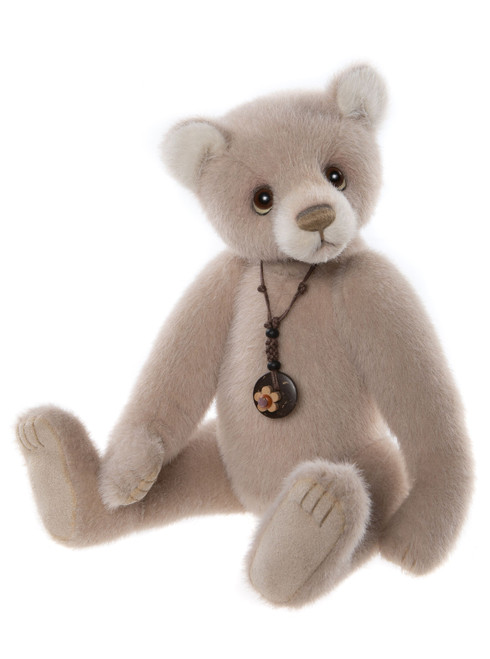Name: Cinderella
Character: Bear
Special Features: The story of the fair maiden called Aschenputtel and the story of the glass slipper is a worldwide favorite, with more than 500 published variations in dozens of languages. The German version, by the Brothers Grimm, was published in 1812. As the newest edition in our Fairy Tale Series, Aschenputtel takes her place alongside the previous four highly successful limited editions. The centerpiece of the set is a blonde Teddy bear, who wears an elaborate felt dress that has been delicately hand painted. She is accompanied by two highly detailed doves. It's a wonderful three-piece set that brings the famous folk tale vividly to life.
Limited Edition: 1,000
Fabric: Mohair
Colour:Beige
Size: 16 cm / 6"
Eyes: Safety Eyes
Ear Tag: White Tag, Gold Plated Button in Ear
Jointed: 5 Way Jointed
Sound Mechanism: None
Cleaning: Surface Wash Only
Origin: Made in Germany
HISTORY OF STEIFF
24 July 1847, Margarete Steiff was born in Giengen, near Ulm, Germany, the third of four children. Her father was a master builder, Friedrich Steiff, her mother Maria Margarete Steiff, née Hähnle. When Margarete was 18 months old, she suffered a high fever and as a result her legs became paralysed and it was painful to use her right arm. Three years later, a doctor in Ulm diagnosed her with polio. Full of zest for life, Margarete fought to lead a normal life. She was taken to school in a handcart by her siblings and neighbouring children. A woman living near the school carried her up into the classroom every day. In spite of the pain in her right hand, Margarete also took sewing lessons, initially against her father's wishes. When she was 15 her Sisters opened a dressmaking shop that Margarete workied in Part Time At 17, she finally completed her training as a seamstress. When her sisters left town Margarete continued on her own. Margarete's father converted the family home and set up a workroom for her - a small dressmaking workshop. From her first earnings, Margarete bought a sewing machine of her own. Because the flywheel on the right-hand side was difficult for Margarete to operate, she had the ingenious idea of simply turning the machine around.
In 1877 Adolf Glatz, her cousin's husband, advised her to go into business on her own. Margarete opened a ready-to-wear felt clothing business to sell clothing and household articles she made herself. Before long, she was able to take on several seamstresses. In an issue of a magazine called "Modenwelt" dated 8th December 1879, Margarete saw a pattern for a small elephant made of fabric. Based on this design, she sewed a pincushion shaped like a small elephant, the "Elefäntle". Soon the small fabric animals proved to be very popular - as toys for children.
The official date of foundation of Margarete Steiff GmbH was in 1880. The "Elefäntle" developed into the company's first big-selling product. Her younger brother, Fritz, successfully sold the felt elephants at the nearby Heidenheim market. Six years later, Margarete had sold over 5,000 elephants. At this point, Margarete also designed other fabric animals. 10 years later Margarete's brother Fritz built his disabled sister a house with a suitably equipped living area on the first floor and a small shop on the ground floor. The house was named "Felt Toy Manufacturing Facility" (Filz-Spielwaren-Fabrik). Today, the street in which this house is found is called "Margarete-Steiff-Strasse".
The first illustrated Steiff catalogue appeared in 1892, showing the wide range of products available. The original elephants were joined by monkeys, donkeys, horses, camels, pigs, mice, dogs, cats, rabbits and giraffes. The catalogue also reflected Margarete's motto: "Only the best is good enough for children".
On 3 March 1893, the felt toy manufacturing facility was entered in the commercial register as "Margarete Steiff, felt toy factory Giengen/Brenz". The toys were showcased for the first time at the Leipzig Toy Fair in 1893. Margarete now had a workforce of four seamstresses and ten outworkers.
Richard Steiff, Margarete's favourite nephew, joined the company in 1897. Richard studied at the School of Art in Stuttgart as well as studying in England. His sketches of animals form the basis of many Steiff creations Richard designed "Bear 55 PB", the world's first toy bear with jointed arms and legs in 1902. While looking for a suitable material for the fur, Richard found the cuddly and dyeable mohair plush, manufactured by the Schulte pile-fabric weaving mill in Duisburg. Margarete herself was rather sceptical, but allowed Richard to present his bear at the Leipzig Toy Fair in 1903. The breakthrough came when an American businessman discovered the bear and placed an order for 3,000. The bear enjoyed unprecedented levels of sales in the USA, where, from 1906 onwards, it is sold under the name "Teddy bear" - after the US President Theodore "Teddy" Roosevelt.
The trademark "Steiff - Button in Ear" was developed by another of Margarete's nephews, Franz Steiff in 1904. The aim of this trademark was to fend off the vast numbers of cheap imitations and to make the company's own high-quality products unmistakable. The International Company Margarete Steiff GmbH - was Founded in 1906 and continues to this day. The company hit the international market in 1907 974,000 Teddy bears were produced by 400 staff and 1,800 outworkers - making a total of approximately 1,700,000 toys. The product range was constantly expanded.
On 9 May 1909 Margarete Steiff died of pneumonia at the age of 61. A hard blow for the whole Steiff family, her friends and her employees. Margarete's nephews took over the running of the company and people all over the world have been keeping her flame alive ever since. Margarete Steiff created something that is larger than lif




